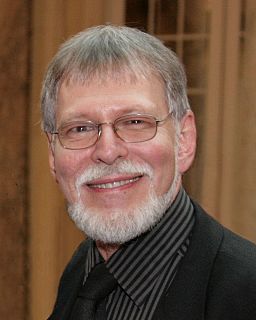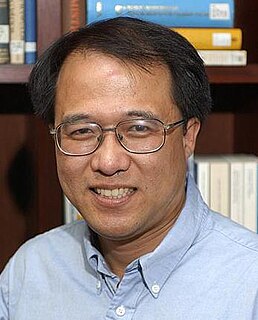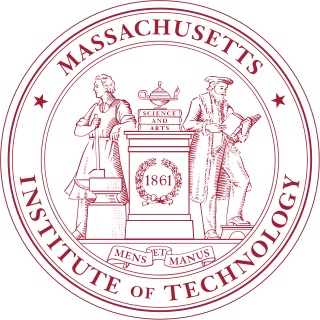Computational chemistry is a branch of chemistry that uses computer simulation to assist in solving chemical problems. It uses methods of theoretical chemistry, incorporated into efficient computer programs, to calculate the structures and properties of molecules and solids. It is necessary because, apart from relatively recent results concerning the hydrogen molecular ion, the quantum many-body problem cannot be solved analytically, much less in closed form. While computational results normally complement the information obtained by chemical experiments, it can in some cases predict hitherto unobserved chemical phenomena. It is widely used in the design of new drugs and materials.
Psi or the initials PSI or Ψ may refer to:
Quantum chemistry is a branch of chemistry whose primary focus is the application of quantum mechanics in physical models and experiments of chemical systems. It is also called molecular quantum mechanics.

A data model is an abstract model that organizes elements of data and standardizes how they relate to one another and to properties of the real world entities. For instance, a data model may specify that the data element representing a car be composed of a number of other elements which, in turn, represent the color and size of the car and define its owner.
Computational archaeology describes computer-based analytical methods for the study of long-term human behaviour and behavioural evolution. As with other sub-disciplines that have prefixed 'computational' to their name, the term is reserved for methods that could not realistically be performed without the aid of a computer.

David Joseph Bohm was an American scientist who has been described as one of the most significant theoretical physicists of the 20th century and who contributed unorthodox ideas to quantum theory, neuropsychology and the philosophy of mind.

Computational fluid dynamics (CFD) is a branch of fluid mechanics that uses numerical analysis and data structures to analyze and solve problems that involve fluid flows. Computers are used to perform the calculations required to simulate the free-stream flow of the fluid, and the interaction of the fluid with surfaces defined by boundary conditions. With high-speed supercomputers, better solutions can be achieved, and are often required to solve the largest and most complex problems. Ongoing research yields software that improves the accuracy and speed of complex simulation scenarios such as transonic or turbulent flows. Initial validation of such software is typically performed using experimental apparatus such as wind tunnels. In addition, previously performed analytical or empirical analysis of a particular problem can be used for comparison. A final validation is often performed using full-scale testing, such as flight tests.
Contour crafting is a building printing technology being researched by Behrokh Khoshnevis of the University of Southern California's Information Sciences Institute that uses a computer-controlled crane or gantry to build edifices rapidly and efficiently with substantially less manual labor. It was originally conceived as a method to construct molds for industrial parts. Khoshnevis decided to adapt the technology for rapid home construction as a way to rebuild after natural disasters, like the devastating earthquakes that have plagued his native Iran.

Edward Nash Yourdon was an American software engineer, computer consultant, author and lecturer, and software engineering methodology pioneer. He was one of the lead developers of the structured analysis techniques of the 1970s and a co-developer of both the Yourdon/Whitehead method for object-oriented analysis/design in the late 1980s and the Coad/Yourdon methodology for object-oriented analysis/design in the 1990s.

Charles Eric Leiserson is a computer scientist, specializing in the theory of parallel computing and distributed computing, and particularly practical applications thereof. As part of this effort, he developed the Cilk multithreaded language. He invented the fat-tree interconnection network, a hardware-universal interconnection network used in many supercomputers, including the Connection Machine CM5, for which he was network architect. He helped pioneer the development of VLSI theory, including the retiming method of digital optimization with James B. Saxe and systolic arrays with H. T. Kung. He conceived of the notion of cache-oblivious algorithms, which are algorithms that have no tuning parameters for cache size or cache-line length, but nevertheless use cache near-optimally. He developed the Cilk language for multithreaded programming, which uses a provably good work-stealing algorithm for scheduling. Leiserson coauthored the standard algorithms textbook Introduction to Algorithms together with Thomas H. Cormen, Ronald L. Rivest, and Clifford Stein.
Lotus Dev. Corp. v. Borland Int'l, Inc., 516 U.S. 233 (1996), is a United States Supreme Court case that tested the extent of software copyright. The lower court had held that copyright does not extend to the user interface of a computer program, such as the text and layout of menus. Due to the recusal of one justice, the Supreme Court decided the case with an eight-member bench that split evenly, leaving the lower court's decision affirmed but setting no national precedent.

Larry LeRoy Constantine is an American software engineer, professor in the Center for Exact Sciences and Engineering at the University of Madeira Portugal, and considered one of the pioneers of computing. He has contributed numerous concepts and techniques forming the foundations of modern practice in software engineering and applications design and development.
Atomistix ToolKit (ATK) is a commercial software for atomic-scale modeling and simulation of nanosystems. The software was originally developed by Atomistix A/S, and was later acquired by QuantumWise following the Atomistix bankruptcy.
John Nicholas "Nick" Newman is an American naval architect noted for his contributions to marine hydrodynamics. Together with David Evans, he initiated the International Workshop on Water Waves and Floating Bodies. He is also known for his contribution in the development of the wave–structure interaction code WAMIT. He is currently emeritus professor of Naval Architecture at Massachusetts Institute of Technology.

Xiao-Gang Wen is a Chinese-American physicist. He is a Cecil and Ida Green Professor of Physics at the Massachusetts Institute of Technology and Distinguished Visiting Research Chair at the Perimeter Institute for Theoretical Physics. His expertise is in condensed matter theory in strongly correlated electronic systems. In Oct. 2016, he was awarded the Oliver E. Buckley Condensed Matter Prize.
Firehole Composites is a supplier of computer-aided engineering (CAE) software and consulting services specializing in analysis of composite materials. Founded in 2000, the company's mission is to provide enabling technologies to further the widespread use of composite materials. Their products include Helius:MCT, Helius:CompositePro, Helius:MatSim, and Prospector:Composites.
Universal Systems Language (USL) is a modeling language and formal method for the specification and design of software and other complex systems. It was designed by Margaret Hamilton based on her experiences writing flight software for the Apollo program. The language is implemented through the 001 Tool Suite software by Hamilton Technologies, Inc. USL evolved from 001AXES which in turn evolved from AXES all of which are based on Hamilton's axioms of control. The 001 Tool Suite uses the preventative concept of Development Before the Fact (DBTF) for its life-cycle development process. DBTF eliminates errors as early as possible during the development process removing the need to look for errors after-the-fact.
Lee Yuk-Wing was a Professor of Electrical Engineering at the Massachusetts Institute of Technology. He is best known for adapting and popularizing the pioneering work of Norbert Wiener and for his own research on statistical communication theory.

Flexcom is a finite element package used in the offshore oil and gas and marine renewable energy industries. An educational version is also available for universities.
Synageva BioPharma Corp. was a publicly listed biopharmaceutical company headquartered in Lexington, Massachusetts dedicated to discovering, developing and delivering medicines for patients with rare diseases and high unmet medical needs. The company had manufacturing and laboratory locations in Lexington and Holden, Massachusetts, Bogart and Athens Georgia, as well as offices in a variety of locations around the world.










